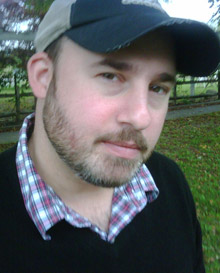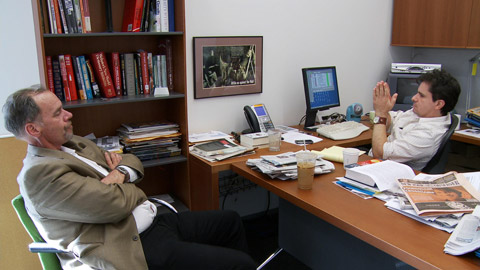
“You can say it’s a play-within-a-play, or you can say that it’s a road movie. I sort of feel like it is almost the Canterbury Tales of media.” |
When I sat down with Andrew Rossi at the Liberty Hotel a couple of weeks back to discuss his latest documentary, Page One: Inside the New York Times, a sometimes critical but mostly adulatory look at the inner workings of the paper of record, the film had just opened in the Big Apple. I found him articulate though a bit humorless; then again, maybe discussing eczema isn't the best way of getting a Harvard Law School grad to crack a smile. Or maybe he had just read Michael Kinsley's scathing review of the film that had appeared in — where else? — the New York Times. Despite the Gray Lady's disdain for his own effort, Rossi nonetheless had only good things to say about the paper's media editor, Bruce Headlam, reporter Brian Stelter, former reporter Tim Arango, and, especially, media columnist David Carr.YOU SPENT AN ENTIRE YEAR SHADOWING REPORTERS FROM THE NEW YORKTIMES. GIVEN YOUR EXPERIENCE, WOULD YOU SAY PRINT JOURNALISM HAS A FUTURE?
I think that the future is a hybrid one. ProPublica is a great example of organizations that live online but are able to amplify their stories by publishing out to places like the Times or 60 Minutes, so these distribution networks like television or newspapers exist, but there's amazing journalism taking place outside of those legacy media organizations, and I think everything points to those two worlds coming together.
YOU SPENT THAT YEAR FOLLOWING THE MEDIA DESK. DID YOU ATTEMPT GAINING ACCESS TO THE OTHER DEPARTMENTS, OR WAS THE MEDIA DESK YOUR FOCUS HEADING IN?
It was my idea always to create a sort of play-within-a-play about watching media journalists tell stories about disruption all across media while we're seeing the journalism that takes place inside the New York Times, so that it's got that meta quality. You can say it's a play-within-a-play, or you can say that it's a road movie. I sort of feel like it is almost the Canterbury Tales of media. It's a journey. There's no finite solution at the end. It's just trying to create the contours of the debate about the current crisis in print and allow the vérité footage inside the New York Times — this front-row seat inside an organization that has original reporting as its mandate — to speak for itself. And so viewers can leave the theater and decide whether what they saw was something that an archaic and wasteful culture is, or they can decide the reverse, that what David and Brian and Bruce are doing is really very vital to our society, and it's up to them.
 |
WHAT'S IN THE AIR AT THE NEW YORK TIMES BUILDING? IT SEEMS THAT EVERYONE WHO WORKS THERE SUFFERS FROM ECZEMA OR PSORIASIS, EVEN A GOOD-LOOKING GUY LIKE TIM ARANGO.
I have eczema too, so it got exacerbated while I was there. You know, it's funny — I think Bruce is a fairly dashing-looking person, and Tim also. There was this Michael Wolff article about the film in AdAge, which said everybody looks so ugly, basically. And David likes to say, "We're a newsroom full of pasty people," or something. I think that, generally speaking, the Renzo Piano building renders everybody inside of it like a sort of gleaming action figure in a way.
 Related
Related:
Review: Page One, For serious kids, Stop the Quinn-sanity!, More 
- Review: Page One
Watching Carr work those stories reveals little about the media revolution, and nothing about its effects on the Times.
- For serious kids
In last week's New York Times , David Brooks suggested that for people who are not parents there are "no grand designs..., no high ambitions. Politics becomes insignificant. Even words like justice lose meaning."
- Stop the Quinn-sanity!
The year is still young, but when the time comes to look back at 2010's media lowlights, the embarrassing demise of Sally Quinn's Washington Post column, "The Party," will almost certainly rank near the top of the list.
- The prince and the paper
When a young Providence Journal reporter was poised to reveal the all-male membership of the Narragansett Lions Club last year, it didn’t sit well with at least one member.
- Less

 Topics
Topics:
Features
, The New York Times, Page One, David Carr